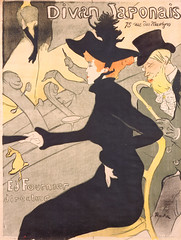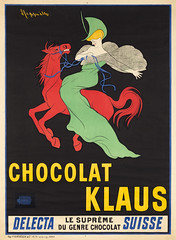Artist Biographies

Henri de Toulouse-Lautrec
(French, 1864–1901)
Henri de Toulouse-Lautrec was born to an aristocratic family in Albi, in southern France. He spent his childhood in various family chateaux and began taking informal sketching and painting lessons from a family friend. He showed an unusual skill from an early age and was especially adept at capturing the movement of horses. In 1882 Lautrec moved to Paris, where he studied painting under Léon Bonnat. He settled in Montmartre, a bohemian district in the north of the city, and frequented cabarets, dance halls, and café-concerts that lined the streets. His first poster—for the Moulin Rouge dance hall in 1891—was an overnight sensation and made Lautrec’s name. Lautrec completed thirty posters before his untimely death at age thirty-six in 1901.
Image: Henri de Toulouse-Lautrec, (French, 1864–1901), Divan Japonais, 1893. Color lithograph. Gift of Mrs. Harry Lynde Bradley. Photo by Larry Sanders.
Alphonse Mucha
(Czech, 1860–1939)
Born in Ivančice, Moravia (present-day Czech Republic), Mucha drew as a hobby through high school and, for work, created scenery for theatre productions as a decorative painter. After a short time painting for a theatre company in Vienna, he moved back to Moravia and received sponsored formal training at the Munich Academy of Fine Arts. He moved to Paris in 1887; his poster career was launched in 1894 when he made a poster for the famed actress Sarah Bernhardt, in her starring role in Gismonda. Mucha’s style is characterized by its combination of a lively, whiplash line, natural forms, and exotic elements drawn from Byzantine and medieval art.

Jules Chéret
(French, 1836–1932)
Chéret, born in Paris, began his artistic career at age thirteen as an apprentice to a lithographer. He worked in London as a young man, and then returned to Paris, opening his own lithographic printing house in 1866. He created posters for cabarets and music halls, as well as for pharmaceutical and consumer products. His work was enthusiastically collected and was praised for its bright colors and fresh design. By the end of the 1880s, critics hailed Chéret as the “king of the poster,” and in 1890, the French government awarded him the Legion of Honor in recognition of his advancement of the artistic poster. Chéret created more than one thousand posters before retiring to Nice, in southern France.
Image: Jules Chéret, (French, 1836–1932), Folies-Bergère: Les Hanlon-Lees, 1878. Color lithograph. Collection Zimmerli Art Museum at Rutgers University, museum purchase, Mindy and Ramon Tublitz Fund 1992.1393. Photo by Jack Abraham, Zimmerli Art Museum.
Théophile-Alexandre Steinlen
(Swiss, 1859–1923)
Steinlen, together with Chéret, Toulouse-Lautrec, Grasset, and Mucha, was one of the five poster artists consistently hailed as masters of the medium in the 1890s. Working in a Realist vein, Steinlen was active as a painter, printmaker, illustrator, and poster designer; he was also a key member of the artistic circle that frequented the Chat Noir (Black Cat), the cabaret artistique that did much to give Montmartre its bohemian character in the 1880s and 1890s. Like Toulouse-Lautrec, Steinlen made posters for many of the entertainments of Montmartre; his 1896 poster for the tour of the Chat Noir cabaret remains an enduring icon of the Belle Époque.

Pierre Bonnard
(French, 1867–1947)
Bonnard received his first poster commission while he was still a law student. His dazzling debut poster of 1891, France-Champagne, drew the attention of passersby and critics. Legend holds that it was this poster that inspired Henri de Toulouse-Lautrec to begin his own highly successful poster career. Despite his obvious skill, Bonnard made fewer than a dozen posters during his long career as a painter and printmaker. The exhibition Posters of Paris features four posters by Bonnard, in addition to a rare preparatory sketch for France-Champagne.
Image: Pierre Bonnard, (French, 1867–1947), France-Champagne, 1889–1891. Color lithograph. Restricted gift of Dr. and Mrs. Martin L. Gecht, 1991.218, The Art Institute of Chicago. Image courtesy of The Art Institute of Chicago.
Eugène Grasset
(French, b. Switzerland, 1845–1917)
Born to a Swiss cabinet designer/maker and sculptor father, Grasset grew up surrounded by art. After studying drawing under François-Louis David Bocion, Grasset went to Zurich to study architecture. Between 1869 and 1871, Grasset worked as a painter, sculptor, and furniture and tapestry designer, as well as a ceramics and jewelry designer. In 1877 Grasset began making postcards and postage stamps, but soon discovered that his strength was in poster art. Together with Jules Chéret, he was considered one of the two pillars of French poster design. Although Grasset never embraced the term Art Nouveau, his work is considered foundational to the development of the style. He also had great influence as a teacher, instructing generations of students.

Leonetto Cappiello
(Italian, 1875–1942, active in France)
Italian-born Cappiello began his career in Paris drawing caricatures for satirical journals such as Le Rire and L’Assiette au beurre. He made his first poster in 1899 and soon hit upon his signature style, which featured bold images set against unmodulated backgrounds. Unlike Jules Chéret, who worked in a painterly style, Cappiello eliminated detail and created iconic images that were easy to read from a distance. The first great poster artist of the twentieth century, Cappiello was skilled at creating image associations, forging a strong link in the viewers’ minds between the image and the product. His lively posters for Klaus Chocolat and Maurin Quina are two such examples, from the more than one thousand posters he made during his busy career.
Image: Leonetto Cappiello, (Italian, 1875–1942, active in France), Chocolat Klaus, 1903. Color lithograph. The Rennert Collection, New York City. Image courtesy of Jack Rennert, New York.


